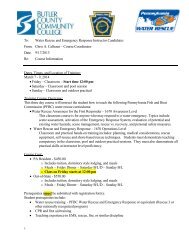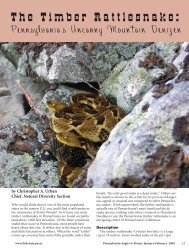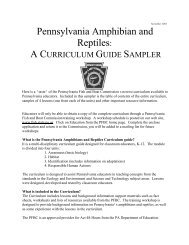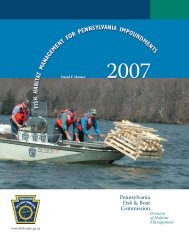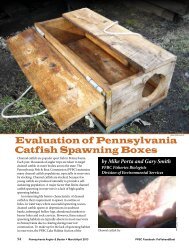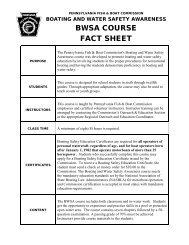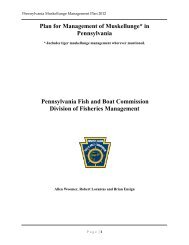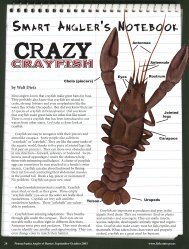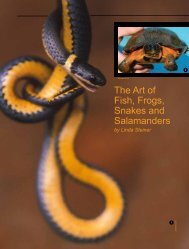june 1963 boating issue - Pennsylvania Fish and Boat Commission
june 1963 boating issue - Pennsylvania Fish and Boat Commission
june 1963 boating issue - Pennsylvania Fish and Boat Commission
You also want an ePaper? Increase the reach of your titles
YUMPU automatically turns print PDFs into web optimized ePapers that Google loves.
all shapes, sizes <strong>and</strong> actions. I can recall one old bruiser that<br />
Came a full fifty feet out of hiding for an old River Runt Spook.<br />
' was fishing the tail of a broad pool having worked my way<br />
downstream from the head. I hadn't had a strike despite the<br />
'Set that I picked my locations <strong>and</strong> had cast carefully, practically<br />
calling the shots. While changing lures, I snapped on<br />
'he River Runt. The cast was to a rook in the center of the<br />
Pool, a wonderful resting place for the big fish that come into<br />
'hat lower water <strong>and</strong> stay there, frustrating all who try for<br />
'hem by orthodox means.<br />
The River Runt was hard to h<strong>and</strong>le, for the faster I retrieved,<br />
'he deeper it went, so, I fed out line while keeping the rod bent<br />
against its downstream course. It must have wobbled its way<br />
at least 200 feet downstream when all of a sudden I felt a jolt,<br />
distantly I whipped the rod back, lifting the line in a razor<br />
cut off the water. Snagged? No sir . . . there was the flash<br />
01<br />
a fish <strong>and</strong> the reel drag started to buzz <strong>and</strong> never quite<br />
popped. When that finny gent came to the end, I snubbed him,<br />
'he only hope. I swear he must have gone five feet in a long<br />
tarponlike tailwalk <strong>and</strong> then up—up! The line went slack but<br />
I didn't care for I had learned a secret of the big river . . . the<br />
w<br />
ay to a big baby in fast water is to give him something fishy<br />
• • . something large <strong>and</strong> formidable. I wish that every lure 1<br />
have lost could have taught me what this one did that day!<br />
Bass bugs in the evening, work well on lunkers that feed just<br />
below the fast water of a pool where it slides into a slower<br />
Pace. Don't jerk them, but let them drift, stopping the line<br />
every now <strong>and</strong> then to make them swing into the current.<br />
Sere the drag works to your advantage, despite the teaching<br />
°f the drag-wary dry fly purist. That drag probably looks<br />
"atural for any bug that size should cause some surface disturbance.<br />
Often a few ripples <strong>and</strong> the sight of the big bug<br />
is all that old Mr. Bass needs when he's beginning his nighttime<br />
feeding period.<br />
If I were selecting a rig solely for big, fast stream work<br />
With big spinning lures or small bait-casting lures (almost one<br />
<strong>and</strong> the same), I'd choose a 7-foot tubular glass with a fast<br />
tip <strong>and</strong> plenty of solid backbone in the mid-section. The fast<br />
tip makes the rig more versatile for other fishing, while offering<br />
Just the right power for pinpointing the long casts to those midstream<br />
holes. This type of rod offers great striking qualities, too,<br />
f°r it is strong enough to lift a long line quickly <strong>and</strong> set the<br />
barbs. When a river smallmouth is hitting you, that strength<br />
is none too much to set the hook.<br />
Playing big bass in thick, heavy water, requires you to let<br />
the fish do the dictating, for he will anyway. With a long line<br />
°ut it is hard to stop a downstream run <strong>and</strong> I've found that<br />
the best practice in this situation is to relax pressure entirely.<br />
Pish don't like to run downstream with the current <strong>and</strong> when<br />
'hey find the pressure relaxed, will immediately head back<br />
upstream. This is the point you have to watch for it is right<br />
here, with plenty of slack line, they will usually take to jumping.<br />
Keep 'em down by testing the pull against them, just<br />
Enough so they will battle themselves out heading into the<br />
current. Now with the current working in your favor, let them<br />
drop down to a slack pocket <strong>and</strong> for the final netting, bring<br />
them in at the head of the quiet water, leaving a comfortable<br />
margin for them to roust about without getting back into the<br />
fast stuff for one last terrifying run downstream. If the hook<br />
has been wearing a hole, that last run may be all they need<br />
for leverage. Once they get it, your trophy is only a myth or<br />
'he "one that got away!"<br />
Play big fish until they are almost spent <strong>and</strong> don't make<br />
any sudden movement when they swim by those first few times<br />
for they are simply looking you over. When they start turning<br />
on their side have the net ready.<br />
JUNE—<strong>1963</strong><br />
When the Shad Flies Hatch<br />
By ALBERT G. SHIMMEL<br />
The expert angler is aware that the opening of trout season<br />
is not favorable to his art except on rare occasions. As the water<br />
warms under the lengthening days the hatches increase in number<br />
<strong>and</strong> intensity until late May <strong>and</strong> eai\y June mark the hatching<br />
of the largest of the Ephemeridae, the Green Drake or Shad<br />
fly. This is the one time of the year the angler finds large brown<br />
trout willing to feed at the surface during daylight hours.<br />
The Shad Fly hatch marks the peak of abundance not only of<br />
this fly but of both abundance <strong>and</strong> varie.y of species. Because of<br />
the numbers of surface feeding fish this has been nicknamed the<br />
"Duffers Fortnight."<br />
In order to underst<strong>and</strong> some of the effective methods of taking<br />
fish when the Shad is on it is necessary to be familiar with somj<br />
of its life history.<br />
The nymph burrows in the mud or s<strong>and</strong> of the stream bottom<br />
<strong>and</strong> are not available to trout in any quantity except when they<br />
are actually hatching. It is then that they emerge from their<br />
burrows. A tiny bubble of gas forms at the thorax <strong>and</strong> they rise<br />
toward the surface with a bucking motion. Here the nymph<br />
floats, the skin breaks open, the adult emerges <strong>and</strong> using the<br />
discarded nymph shuck for a raft, floats for the few seconds it<br />
requires for the wings to stiffen. It then lifts from the water <strong>and</strong><br />
Hies away to the trees. Here it again sheds its skin <strong>and</strong> so alters<br />
its appearance that it is difficult for any but a trained observer<br />
to believe that it is the same fly.<br />
The nymph is a dirty yellow gray in color. The sub-imago is<br />
dull lemon yellow with dark brown or black mottlings. The<br />
wings are semi-transparent yellow with black barrings. After<br />
the second adult molt the body becomes elongated <strong>and</strong> is chalkwhite<br />
in color. The wings are transparent <strong>and</strong> retain their black<br />
markings. In this stage it returns to the water to mate <strong>and</strong> lay<br />
eggs. The flight begins at sundown, high above the trees <strong>and</strong><br />
gradually descends until the water is literally covered with<br />
floating insects. Anglers now crowd the streams, casting to the<br />
rise <strong>and</strong> hoping for a trophy trout. Paradoxically the angler<br />
often fails because his artificial is lost in the multitude of<br />
naturals.<br />
One of the most effective methods of angling the Shad Fly<br />
hatch is to try the stream in the morning. The nymphs leave<br />
their burrows <strong>and</strong> become active some time before reaching the<br />
surface. Trout find these animated morsels rather attractive. A<br />
nymph either of the fly vise material or one of the molded plastic<br />
specimens is used. Cast it into the deeper, more calm portions<br />
of the pools <strong>and</strong> allow it to sink. Strangely enough the fish<br />
seldom take this pattern on the way down. After it has reached<br />
the bottom move it toward the surface in slow pulls with pauses<br />
between of sufficient length to allow the artificial to settle<br />
slightly. Trout many times follow them all the way to the surface<br />
<strong>and</strong> then strike viciously just as the angler is about to lift<br />
the lure for another cast. At other times the take is slow <strong>and</strong><br />
del.berate. In the faster water a small dirty yellow streamer of<br />
marabou feathers is allowed to drift with the current with an<br />
occasional twitch to give it life. These streamers should be<br />
slightly over an inch long <strong>and</strong> have a body of creamy red fox<br />
fur spun on yellow silk. Keep the body rather rough to imitate<br />
the body of the nymph. It will also collect air bubbles <strong>and</strong> add<br />
realism to the imitation.<br />
If you have confined your fishing during this hatch to the tag<br />
end of the day be sure to try the morning from about nine a.m.<br />
on. I am sure you will be agreeably surprised <strong>and</strong> have the<br />
further advantage of not being trampled in the evening rush.<br />
17




